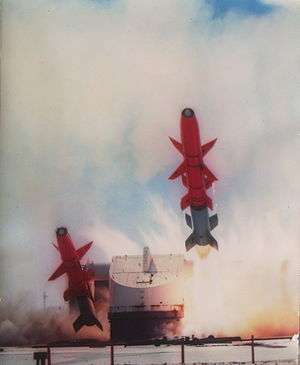Operation Bumblebee

Operation Bumblebee was a US Navy effort to develop surface to air missiles (SAMs) to provide a mid-range layer of anti-aircraft defence, between anti-aircraft guns in the short range and fighter aircraft operating at long range. A major reason for the Bumblebee efforts was the need to attack bombers before they could launch standoff anti-shipping weapons, as these aircraft might never enter the range of the shipboard guns.
Bumblebee originally concentrated on a ramjet powered design, and the initial Applied Physics Lab PTV-N-4 Cobra/BTV (Propulsion Test Vehicle/Burner Test Vehicle)[1] was flown in October 1945.[2] The Cobra eventually emerged as the RIM-8 Talos, which entered service on 28 May 1958 aboard the USS Galveston. As part of the development program, several other vehicles were also developed. One of these developed into the RIM-2 Terrier, which gained operational status on the USS Canberra on 15 June 1956, two years before the Talos. The Terrier was later modified as a short-range missile system for smaller ships, entering service in 1963 as the RIM-24 Tartar. Together, the three missiles were known as the "3 T's".
Bumblebee was not the only early Navy SAM project; the SAM-N-2 Lark was rushed into production as a short-range counter to the Kamikaze threat, but never matured into an operational weapon.
Origin
Navy ships were hit by air-launched Henschel Hs 293 glide bombs and Fritz X anti-ship missiles during 1943. A ramjet-powered anti-aircraft missile was proposed to destroy aircraft launching such weapons while remaining beyond the range of shipboard artillery.[3] Initial performance goals were target intercept at a horizontal range of 10 miles and 30,000 feet altitude, with a 300 to 600 pound warhead for a 30 to 60 percent kill probability.[4] Heavy shipping losses to Kamikaze attacks during the Battle of Okinawa provided additional incentive for guided missile development.[5]
Field testing
In addition to initial tests at the Island Beach, New Jersey, and Fort Miles, Delaware, temporary sites,[6] Camp Davis, North Carolina, was used for Operation Bumblebee from c. June 1, 1946, to July 28, 1948.[7] Topsail Island, North Carolina, became the permanent Bumblebee testing and launch facility in March 1947.[6] The Topsail Historical Society hosts the Missiles and More Museum at the site. Testing was transferred to Naval Air Weapons Station China Lake and then to White Sands Missile Range in 1951 where USS Desert Ship (LLS-1) was built as a prototype Talos launch facility.[5]
Program results
The RIM-2 Terrier, devised as a test vehicle, became operational as a fleet anti-aircraft missile aboard USS Boston in 1955, and evolved into the RIM-66 Standard. Talos became operational with the fleet aboard USS Galveston in February, 1959, and saw combat use during the Vietnam War. Ramjet knowledge acquired during the program aided development of the XB-70 Valkyrie and the SR-71 Blackbird.[4] Solid fuel boosters developed to bring the ramjet to operational velocity formed the basis for larger solid fuel rocket motors for ICBMs, satellite launch vehicles and the space shuttle.[4]
References
- ↑ Parsch, Andreas. "PTV-N-4". Retrieved 2009-07-30.
- ↑ Parsch, Andreas. "Cobra-BTV". astronautix.com. Retrieved 2009-03-19.
- ↑ Galdorisi, George. "U.S. Navy Missile Defense: Getting Surface-to-Air Missile Development Started". Defense Media Network. Retrieved 8 March 2016.
- 1 2 3 "Talos Missile History". Hays, Philip R. Retrieved 2010-08-19.
- 1 2 "A Brief History of White Sands Proving Ground 1941-1965" (PDF). New Mexico State University. Retrieved 2010-08-19.
- 1 2 "US Naval Ordnance Test Facilities, Topsail Island MPS". From Sand Dunes to Sonic Booms. NPS.gov. Retrieved 2009-03-19.
- ↑ Jones, Wilbur D. (Jr) (2005). The Journey Continues: The World War II Home Front. Shippensburg, PA: White Mane Books. p. 83. ISBN 1-57249-365-8.